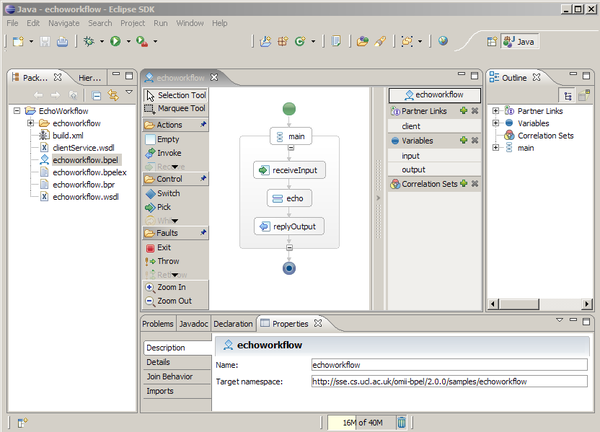Modelling, monitoring, executing scientific workflows with BPEL (OMII-BPEL)
The OMII has a budget of £3M allocated for spending outside the OMII on a managed programme funding the development of essential middleware components. Over £2M has now been invested in harvesting software components from existing middleware projects - ensuring that they are integrated with the OMII platform, documented and tested. The managed programme will address specific gaps in the existing middleware infrastructure that have been identified by the OMII, the UK e-Science community, the OMII Technical Advisory Board and our industrial collaborators. With the recent release of OMII 2.0.0, the first components from this programme are beginning to appear in the OMII distribution.
 |
The Software Systems Engineering Group is contributing a modelling, monitoring and execution environment for scientific workflows based on the Business Process Execution Language (BPEL). BPEL is the de-facto standard for the composition and orchestration of web services. There are a number of advantages to be gained from adapting BPEL for the orchestration of scientific workflows. The standard is implemented in several industrial strength competing products by IBM, Oracle, ActiveEndpoints and others. There are training courses and certification programmes available for BPEL engineers. BPEL is fully capable of expressing scientific workflows, but because of its focus on business rather than scientific processes implementations of the standard have not yet been tested for large and long running scientific workflows in a grid environment. The project has developed a production-strength modelling, monitoring and an enactment environment for scientific workflows based upon the Business Process Execution Language (BPEL). The environment incorporates a version of the ActiveBPEL engine that was customised and tested by a number of UK e-Science projects for scientific workflows. To model workflows the environment contributes specific extensions (most notably an ActiveBPEL run-time integration) to the BPEL Designer open source tool shown above. The editor inherits many features from the Eclipse platform, such as integration with CVS, platform specific look and feel, repository integration and the web tools platform, which provides support for WSDL and XML Schema editing.
Principal Investigator
Researchers
- <link http://www.cs.ucl.ac.uk/staff/b.wassermann>Bruno Wassermann</link>
- Liang (Ben) Chen
Publications
- B. Wassermann, W. Emmerich, B. Butchart, N. Cameron, L. Chen and J. Patel (2007). Sedna: A BPEL-based environment for visual scientific workflow modelling. In I. J. Taylor, E. Deelman, D. B. Gannon and M. Shields (eds), <link http://www.springer.com/west/home/computer/communications?SGWID=4-148-22-173663723-detailsPage=ppmmedia|aboutThisBook>Workflows for e-Science</link>. pp. 428-449. Springer.
- W. Emmerich, B. Butchart, L. Chen, B. Wassermann and S. L. Price (2005). <link http://dx.doi.org/10.1007/s10723-005-9015-3>Grid Service Orchestration using the Business Process Execution Language (BPEL)</link>. Journal of Grid Computing, 3(3-4):283-304.
- L. Chen, B. Wassermann, W. Emmerich and H. Foster (2006). <link http://dx.doi.org/10.1145/1134285.1134511>Web Service Orchestrations with BPEL (Tutorial Summary)</link>. In Proc. of the 28th Int. Conference on Software Engineering, Shanghai, China. pp. 1071-1072. ACM Press.
Funding
The project is funded through the EPSRC e-Science Programme through the OMII Managed Programme (GR/S90843/01) in the amount of GBP 335,395 and will run until February 2008.

